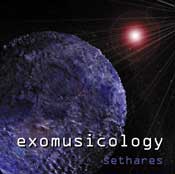What is Exomusicology, anyway?
Though musicology is defined as "the historical and scientific study of music," the term is typically applied only to the study of music from the European classical tradition. "Ethnomusicology" is used to describe the study of nonwestern musical traditions and to the comparative study of different musical cultures. The more general term exomusicology (from the greek prefix exo, meaning 'external to' or 'outside of') is more appropriate to the study of nonhuman musical traditions, much as exobiology refers to the study of non-Earth life forms, and exolinguistics to the study of alien languages. A complete course in exopolitics was available by McGill University a few years ago.
Unfortunately, since musical cultures from a variety of worlds are unavailable for study at the present time, the practice of exomusicology remains speculative. The main tool of speculative exomusicology is the "thought experiment" which involves the music and culture of fictitious creatures and nonexistent alien species. The primary goal is that by thinking about what music might sound like and how musical instruments might be used in the context of various alien cultures, we might see more clearly what music means to ourselves.
|
EXOMUSICOLOGY - the quest for the music of alien cultures - first contact with nonharmonic musical worlds.
|
|
A key idea is that consonance and dissonance are not inherent qualities of intervals, but are dependent on the spectrum, timbre, or tonal quality of the sound. Specially designed dissonance curves show how to predict the most consonant intervals for a given sound, and these intervals define a musical scale. Musicians and composers can create sounds according to the needs of the music, rather than having to compose around the sounds of a few common instruments. For instance, by designing special timbres, it is now possible to play consonantly in 10-tet, as in Isochronism and Anima. The overall effect is unusual, otherworldly, but it is not necessarily jarring, dissonant, or noisy (though it can be noisy or jarring or dissonant if desired - consider Nexus). You can find out more about how this works by clicking here, or you can check out my book Tuning Timbre Spectrum Scale.
EXOMUSICOLOGY contains the following musical pieces, several of which are available for download in mp3 format - just follow the links...
- Apprehensions of Time 3:18
- Percussive elements engage in melodic dialog. Such rhythmic riddles form the basis of temporal motion in many musical cultures by isolating small instants of time.
-
- Sympathetic Metaphor 3:48
- Played with an astral guitar built with 19 tones in each octave, the melody dances pensively on a delicately balanced timbre.
-
- Local Anomaly 3:27
- The elastic pitches of the triangulaika adapt so that at each moment the intervals are maximally consonant. Musical jokes such as this can be found throughout known space.
- Immanent Sphere 4:17
- Spheres of undulating sound, each note is an overtone of a single underlying pitch, a harmonic enigma balanced between pantonality and xentonality.
|
|
Nonharmonic does not mean noisy!
|
- Persistence of Time 4:54
- Paleo-futuristic polyrhythms beat three against two, an audio conundrum where all intervals adapt to maximize instantaneous consonance.
- Isochronism 3:55
- When there are ten equal tones in each octave, special instruments such as the kleinette (see illustration) are needed to align the partials into consonant patterns.
- Anima 4:03
- Like Isochronism, this mysterious ten tone equal tempered piece uses modified timbres to effect a balance between coherence and chaos, between the obvious and the obscure. (Lyrics translated courtesy of the Interstellar Language Institute).
- Over Venus 4:25
- This melody floats above a single low tone, playing on the multidimensional harmonics of the Klein trumpet. In its native land it is a melody of meditation, a consonance for contemplation.
- Free from Gravity 3:28
- A celebration of living in an asteroid belt, where planetary forces are a distantly remembered encumberance, and three dimensional sports and dances thrive. The melodic and harmonic motion conform to a simple additive scale, a regular lattice that organizes pitch space directly in frequency.
- When Everything was Simultaneous 3:50
- In this creation myth, all things that exist arise from a single moment in time. The alien voices, their harmonics deranged by spectral mappings, warn of the danger inherent in even an instant of clarity.
- Temporal Consciousness 2:59
- Coming of age of a culture: this song yearns for simpler days unburdened by self knowledge. Spectral segments are jumbled, spawning the chatter and jabber of collective voices that rise in a pandemonium of perplexity.
- Intersecting Spheres 3:33
- Each drone in this mythology is a spirit, each melody is a manifestation of a higher being. Understanding the music "of the spheres" is a path towards enlightenment, and each melodic phrase, each harmonic passage is an overtone on that path.
|
EXOMUSICOLOGY, in the guise of exploring the music of alien cultures, explores some of the possible nonharmonic musical worlds.
|
|
- Pulsing Silences 3:33
- Ululations of radiation from cosmic particles are patterned into a single living note that changes without moving, that grows while remaining still. Even if there were only one note, there would still be music.
- Recalled Opus 3:45
- A lost colony of humans remembers the old styles, though with striking adaptive changes. At each instant in time, these "violins" strive to minimize dissonance.
- Nexus 3:46
- The harmonic series is capable of a wide variety of tonal expressions that are highly regarded throughout the galaxy. Its subliminal influence provides a unifying force in many societies, even when it is handled with such dissonant disregard as in this knotty unvocalized chant.
- Sonork 3:15
- This instrumental accompanies the Rite of Ascension, a traditional Klingon coming of age ritual. The origin of each sound is a cymbal; the origin of each rhythm is a symbol representing the passage of time.
- Rojqoq 3:45
- An old Klingon song stating that the proposed alliance was doomed to failure, that peace with so vile an enemy was impossible, that even the thought of such a treaty was dishonorable. It is not roj (genuine peace), it is rojqoq ('so-called' peace).
- Pagan's Revenge 3:55
- The trident instruments, tuned to seven equal divisions of the octave, play a theme forwards and then backwards - finally ending on the first note. This melodic palindrome is considered an essential aspect of musical balance in many parts of the milky way. Unfortunately, human ears dont readily perceive this structural element, and so cannot fully appreciate the performance.
- Nothing Broken in Seven 3:29
- More trident music: a simple pattern for children that repeats and imitates itself as it increases and decreases in complexity.
Wondering who could have designed such cool graphics?
All the mp3s are summarized here.
This page has been translated by
Alana Kerimova into
Kazakh,
by Lars Olden into
Norwegian,
by Manuel Gomez into
Spanish,
and by Milica Novak into
Croatian.



![]()